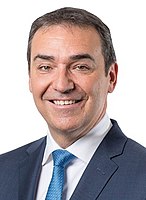Portal:South Australia
The South Australia Portal
South Australia (commonly abbreviated as SA) is a state in the southern central part of Australia. It covers some of the most arid parts of the country. With a total land area of 984,321 square kilometres (380,048 sq mi), it is the fourth-largest of Australia's states and territories by area, and second smallest state by population. It has a total of 1.8 million people. Its population is the second most highly centralised in Australia, after Western Australia, with more than 77 percent of South Australians living in the capital Adelaide, or its environs. Other population centres in the state are relatively small; Mount Gambier, the second-largest centre, has a population of 26,878. South Australia shares borders with all the other mainland states. It is bordered to the west by Western Australia, to the north by the Northern Territory, to the north-east by Queensland, to the east by New South Wales, to the south-east by Victoria, and to the south by the Great Australian Bight. The state comprises less than 8 percent of the Australian population and ranks fifth in population among the six states and two territories. The majority of its people reside in greater Metropolitan Adelaide. Most of the remainder are settled in fertile areas along the south-eastern coast and River Murray. The state's colonial origins are unique in Australia as a freely settled, planned British province, rather than as a convict settlement. Colonial government commenced on 28 December 1836, when the members of the council were sworn in near the Old Gum Tree. As with the rest of the continent, the region has a long history of human occupation by numerous tribes and languages. The South Australian Company established a temporary settlement at Kingscote, Kangaroo Island, on 26 July 1836, five months before Adelaide was founded. The guiding principle behind settlement was that of systematic colonisation, a theory espoused by Edward Gibbon Wakefield that was later employed by the New Zealand Company. The goal was to establish the province as a centre of civilisation for free immigrants, promising civil liberties and religious tolerance. Although its history has been marked by periods of economic hardship, South Australia has remained politically innovative and culturally vibrant. Today, it is known for its fine wine and numerous cultural festivals. The state's economy is dominated by the agricultural, manufacturing and mining industries. (Full article...) Selected article - The 2018 South Australian state election to elect members to the 54th Parliament of South Australia was held on 17 March 2018. All 47 seats in the House of Assembly or lower house, whose members were elected at the 2014 election, and 11 of 22 seats in the Legislative Council or upper house, last filled at the 2010 election, were contested. The record-16-year-incumbent Australian Labor Party (SA) government led by Premier Jay Weatherill was seeking a fifth four-year term, but was defeated by the opposition Liberal Party of Australia (SA), led by Opposition Leader Steven Marshall. Nick Xenophon's new SA Best party unsuccessfully sought to obtain the balance of power. Like federal elections, South Australia has compulsory voting, uses full-preference instant-runoff voting for single-member electorates in the lower house and optional preference single transferable voting in the proportionally represented upper house. The election was conducted by the Electoral Commission of South Australia (ECSA), an independent body answerable to Parliament. (Full article...)Selected Picture - Skyshow was an annual fireworks event held in the South Australian capital of Adelaide since 1985. The half-hour fireworks display is synchronised to pop music and presented by local commercial radio station SAFM. Originating as an Australia Day celebration, the event was subsequently moved to late summer, usually February. General imagesThe following are images from various South Australia-related articles on Wikipedia.
Did You Know... -
CategoriesRelated PortalsWikiProjectsMajor TopicsGeography – Adelaide Hills • Adelaide Plains • Barossa Valley • Clare Valley • Coonawarra • Eyre Peninsula • Fleurieu Peninsula • Flinders Ranges • Kangaroo Island • Limestone Coast • Mid North • Nullarbor Plain • Riverland • Yorke Peninsula History – Kaurna Indigenous people • European settlement • History of Adelaide • Proclamation Day • Australian Overland Telegraph Line • Timeline of South Australian history Towns and Cities – Adelaide • Coober Pedy • Mount Gambier • Murray Bridge| Port Augusta • Port Lincoln • Port Pirie • Victor Harbor • Whyalla Economy and Politics – Premiers • Governors • Parliament • House of Assembly • Electoral districts • Legislative Council • State elections Culture – Croweater • Pie floater • Wine • The Advertiser • Adelaide Festival Centre • Adelaide Entertainment Centre • WOMADelaide • Adelaide Fringe • Elder Park • The Crows • The Power • The Reds • Redbacks • Hindmarsh Stadium • AAMI Stadium • Rundle Mall People – Kaurna Indigenous people • Matthew Flinders • William Light • Charles Sturt • Edward Gibbon Wakefield • John Hindmarsh • George Gawler • Playford family • Don Dunstan More portalsThings you can doHere are some tasks you can do to help with WikiProject Adelaide:
 Associated WikimediaThe following Wikimedia Foundation sister projects provide more on this subject:
Discover Wikipedia using portals | |||||
- Portals with triaged subpages from June 2020
- All portals with triaged subpages
- All portals
- Portals with no named maintainer
- South Australia portal
- Random portal component with 16–20 available image subpages
- Random portal component with more available subpages than specified max
- Random portal component with 6–10 available subpages
- South Australia
- Australian portals
- Portals needing placement of incoming links























































